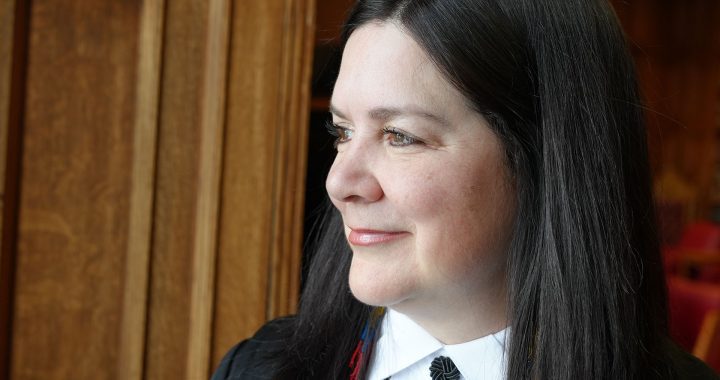First Nation infants subject to "human experimental work" for TB vaccine in 1930s-40s
The nutritional experiments conducted in First Nation communities and in Indian residential schools were not the only example where Canada’s Indigenous population faced treatment as “guinea pigs,” academic research shows.
By Jorge Barrera
APTN National News
The nutritional experiments conducted in First Nation communities and in Indian residential schools were not the only example where Canada’s Indigenous population faced treatment as “guinea pigs,” academic research shows.
First Nation infants were used for Saskatchewan trials of a tuberculosis vaccine that was mired in controversy at the time of the experiment in the 1930s and 1940s.
The subject of nutritional experiments exploded last week after reports surfaced on a study by University of Guelph food historian Ian Mosby. The study found that experiments were conducted in six residential schools and communities in northern Ontario, northern Manitoba, British Columbia, Alberta and Nova Scotia between 1942 and 1952.
Previous and ongoing academic research shows, however, that the nutritional experiments were part of a wider pattern in the medical and scientific community’s approach to Indigenous people at the time which included experimentation and the persistence of certain types of surgeries that were no longer conducted on non-Indigenous people.
Academic research also shows that many Indigenous people who died undergoing medical care for diseases like tuberculosis (TB) were buried in unmarked graves because Indian Affairs would not pay to take their bodies back to their home communities.
“Historians have been reluctant to question medical care because we are enthralled with the power of medicine,” said Brock University professor Maureen Lux, who published a paper on the vaccine trials in 1998 and is currently working on a book that delves into the still thinly-explored realm of the treatment of Indigenous people in sanatoriums. “Once I started looking at what was going and how they were operated and in whose interest, it becomes a fairly dark story.”
The vaccine trial on First Nation children from the Qu’Appelle reserves in southern Saskatchewan is one of those threads in that story.
The bacille Calmette-Guerin (BCG) vaccine trials were backed by the National Research Council and Indian Affairs. While the trials were eventually successful and the vaccine is still around today, one of the doctors involved with the experiment at the time worried about the dangers and believed Ottawa could find itself on the hook if something went wrong.
It was already apparent to medical officials before the trials that TB rates were dramatically lowered by improving the living conditions of First Nation people living on reserve, according the study written by Lux titled, Perfect Subjects: Race Tuberculosis and the Qu’Appelle BCG Vaccine Trial.
Between 1930 and 1932, the tuberculosis rate had been cut in half after a federally-backed Qu’Appelle Demonstration Health Unit began focusing on changing the situation on the ground. It replaced one-room log huts with frame houses, drilled wells to improve water supply, provided families with hens and seed and improved the food given to school children and pregnant women, according to Lux’s study. A nurse was also hired to give care to children suffering from infections disease in their own home.
“The general death rate and the infant mortality rate both also fell. Thus, before the BCG vaccine trials were begun, the tuberculosis death rate had been reduced by half by marginal improvements in living conditions, and especially by segregating those with active tuberculosis,” wrote Lux.
But vaccines were cheaper than paying to improve the conditions of Indian residential schools and reserves or treating people in sanatoriums which could turn into lengthy stays.
Lux said the urgency to conduct the vaccine trials on First Nation infants in southern Saskatchewan was also driven by a fear that Indigenous people would infect the non-Indigenous population with TB.
“They were seen as vectors of disease because TB rates in the non-Aboriginal community were falling quickly. They were better fed and housed, but not so on-reserve,” said Lux, in an interview. “My point in the article was that TB wasn’t the big threat…the big threat was poverty because more kids died of poverty related diseases than from TB.”
The BCG vaccine at the time was controversial. A German experiment in 1930 led to the deaths 71 children after they were given a contaminated strain. At the time of the Qu’Appelle trial, close to 400,000 children had been vaccinated and trials had been conducted in Montreal, but it was still unclear at the time whether the vaccine would regain its virulence. The United States and Britain did not use the BCG vaccine at the time “because of fears that the vaccine was not stable,” wrote Lux.
Worries over the vaccine were expressed in a confidential memo to federal authorities.
“I feel as though it would be unwise to initiate human experimental work among Indian children who are the direct wards of the government, and for which reasons they are not in a position to exercise voluntary cooperation,” wrote Dr. R. George Ferguson, the medical superintendant of the Fort Qu’Appelle Sanatorium, to the president of the National Research Council. “Furthermore in case of difficulties arising, the government itself could not be without responsibility.”
The trial went ahead in 1933 and it proved successful. According to Lux, between 1933 and 1945, 306 infants were vaccinated and 303 were used as a control group. Only six vaccinated infants contracted TB and two died. In the unvaccinated group, 29 caught TB and nine died.
But the vaccine could not protect children from death. Poverty proved to be a far deadlier killer than TB. According to Lux’s paper, 105 children died from causes other than TB within the first seven years of the study. They died from pneumonia and gastroenteritis.
“The BCG trial was a success, but unfortunately the patients died,” wrote Lux.
Lux said in an interview that First Nation patients also underwent trials for streptomycin, an antibiotic that was used to cure TB, at the now defunct Charles Camsell hospital in Edmonton.
Lux said doctors also continued to surgically remove TB from Indigenous patients into the 1950s and 60s, after the procedure was no longer done on the non-Indigenous population.
“Do we interpret that surgeons and medical directors thought they were doing right and never questioning the assumption that these people were going to actually spread TB when they actually weren’t?” said Lux. “They could do it and they did it and that is as shocking as any kind of experiment.”
During her research on the book about sanatoriums and Indian hospitals, Lux said she interviewed many elders who believed they underwent medical experiments.
“Every one of them said, ‘yeah, they were using us as guinea pigs.’ Whether they were, or people didn’t understand what treatments they were getting, or physicians weren’t telling people, it is really hard to pin down…as a historian to say yes…But the people who spent time in the hospitals felt they were guinea pigs.”
Whether there were other types of experimentation beyond what has already surfaced, Lux said she can’t give a definite answer.
However, the existing record of the medical system’s treatment of Indigenous patients is already a dark one, she said.
“It is pretty depressing. It is just document after document. They treated these people like they were not even human,” she said. “It is definitely the hardest thing I have ever done.”
Lux’s book goes for peer review this fall and should be published in about a year.
@JorgeBarrera











testing of experimental drugs continues with children in care, who through child and youth mental health are presecribed medications still in trial stage of approval in Canada.
🙁 For as long as I can remember my mom has said that she
was probably used for experiments. From the age of eight to the age of twelve
she was placed in what was called a preventorium which was a building for
patients infected with tuberculosis that did not yet have an active form of the
disease. That is all fine and dandy as this was the norm throughout North
America for non-native people too but what is peculiar in my mom’s case is that
there are absolutely no records of any kind anywhere in all of Canada. We
discovered this when she had breast cancer in 1986. All her doctors at that
time never heard of such practice and x-rays showed no scars of TB. For the
duration of my mom’s radiation treatments and for the year following she had to
take medication to prevent an onset of TB. They had to know for sure if she had
TB or not as having radiation treatments could trigger another onset of the
disease if indeed she did have it in her youth. Another peculiarity is that
none of her own siblings were placed in the building with her. She and her
cousin of the same age and from the same home village in Kingcome Inlet were
transported from their homes to the building on the same day and were released on a New Year’s Day. The preventorium was connected to St. Michael’s Indian Residential School. For almost the whole duration of my mom’s placement at the preventorium she was strictly confined to bed, was never given any education, recreation and such. Meals were minimal and of very little nutrition. Phtt! It’s surprising that the children in the building never died of malnutrition. On a daily basis the children were stripped and were given a rub down of an unknown lotion and placed under what my mom describes as three heat lamps connected. Their groin and breast body areas were covered with a towel. suspect the towel coverage wasn’t meant for protection but to hide from view. They also had to wear blindfolding. 🙁
I think there is more to this story.
I was taken into care when I was 10 months old. Adopted just before age 3. I had to go through many years of chest x-rays because of positive TB skin tests. I was somehow exposed to TB but I don’t know my history well enough to know from where.
I am originally from a First Nation in Southwestern Ontario. Was there experiments going on there as well? Will we ever know the true depth of the governments genocide plans involving the First Nations people of Canada?